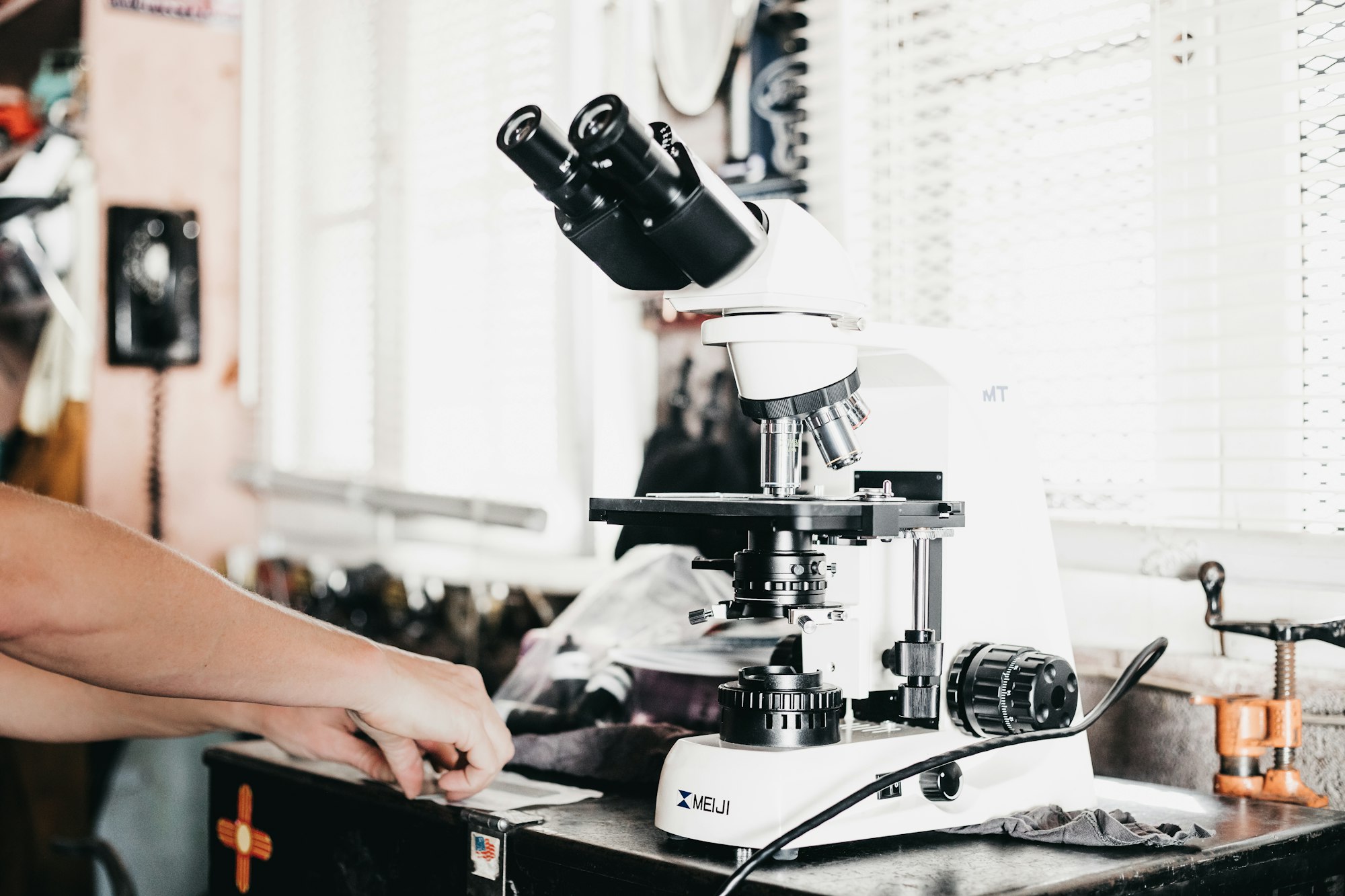Flipped learning: Extinct or endemic?
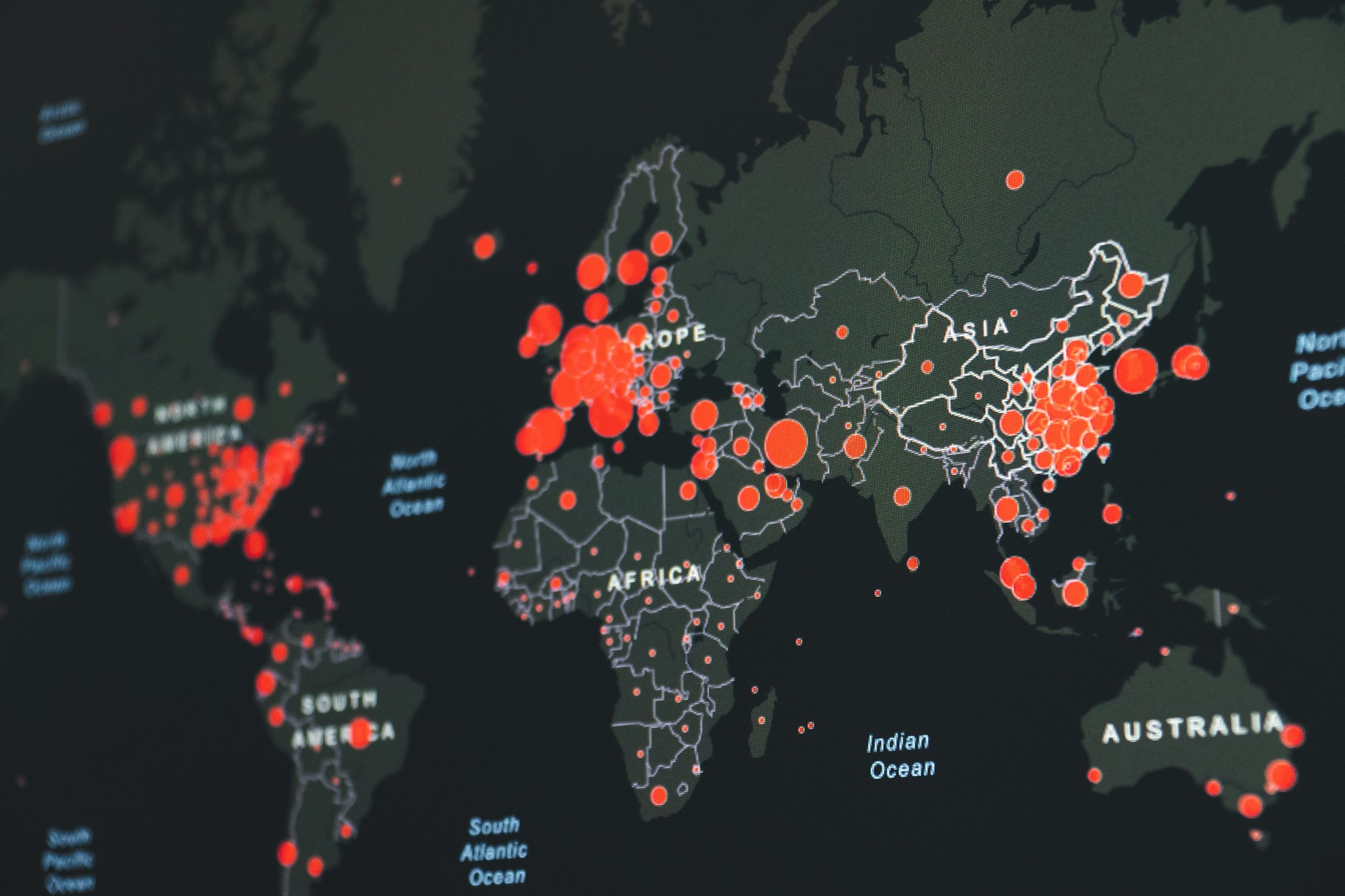
Background: Back in February, I gave the keynote address for the IFLIP symposium on flipped learning hosted by Southern Illinois University at Edwardsville. Originally planned to be in-person because the Delta surge was easing, it was moved to online just a month before the event when Omicron hit. (Then there was a major snowstorm the day before, so it all worked out.) The talk itself was inspired by the saga of trying to schedule it, as it paralleled Covid's evolution. Here's the text of that talk, edited somewhat.
When I was first contacted about speaking today, it was not just 2021, it was post-Delta/pre-Omicron 2021. Cases and deaths were on the decline, vaccines and boosters were readily available, and so this event was planned to be in person -- it was going to be the first in-person talk I'd given since March 2020, about 10 days before everything shut down. But then Omicron hit, and the entire event was made virtual, and it turned out that was a good idea after all thanks to the Midwest winter weather we all know and love.
Thankfully, the data from recent days seem to be indicating that while Covid is still a challenge, the Omicron surge may be receding, and in fact there are some tentative headlines now about being in the endgame of the entire pandemic. What's being theorized is that we're moving from a pandemic -- where a contagious disease has a worldwide scale -- to an endemic which is where the disease is found in a community, present but not necessarily manifesting itself often; and when it does manifest, it's not as severe as before. Chicken pox and malaria, for example, are endemic. Some endemic diseases like malaria can still be severe or life-threatening. But generally speaking, according to my friends who are evolutionary biologists, viral diseases that start as extremely potent pandemics, will often follow natural selection into forms that are more transmissible but less deadly.
I'd like to talk about the general idea of things that begin as unusual but highly potent entities, and then over time evolve to become more common but less potent. Viruses often do this; but as I was preparing for this talk, I wondered: Do viral ideas follow the same trajectory? That is, when a novel and viral idea emerges out of nowhere, does it move from something very unusual and potent, to something that has widespread acceptance but also a much lower potency?
There seem to be a great many examples of these ideas. And I want to be real with you: I am concerned that flipped learning is becoming one of them.
Flipped learning's potent origins
Flipped learning has been oddly quiet for the last 5-6 years. In the 2010's, you'd see occasional news items about "flipped classrooms" and they would cause a big stir because this was a radical idea with radical success attached to it. I haven't seen one of those articles since around 2017. Why? Did flipped learning go extinct?
It turns out flipped learning didn't go extinct: It went endemic.
I used to say someday we won't call it the "flipped classroom" any more, but just "the classroom", because flipping will be the norm -- everyone will be doing it on some level. We may well be in those times today. Flipped learning has spread far and wide and is still going. But I wonder if it's losing the early potency that it used to have to enact change in students, faculty, and higher education. If we're talking about Covid, then being common but mild is a great thing. But if that happens to flipped learning, it would be a tragic waste.
So my main point, my call to action for you today is that we can keep flipped learning "viral" --- continuing to spread to every corner of higher education and beyond --- without losing its positive disruptive potency.
I'd now like to explore how we make this happen. But first, a history lesson.
Flipped learning as an organized concept first showed up in the Harvard physics classrooms of Eric Mazur in his early experiments with peer instruction in the 1990s. Then nothing really happened with the idea until the early 2000s when there was a burst of experimentation. Economics professors at Miami University in Ohio invented something they called the "inverted classroom", and a lone computer science professor at Cedarville University, also in Ohio, flipped his webpage design class and was the first person to use the term "flipping" to describe it. Jeremy Strayer, also in Ohio at Ohio State University, did his PhD thesis on flipped instruction. So there were early rumblings that something disruptive was taking shape.
But flipped instruction didn't go truly viral until Jon Bergmann and Aaron Sams wrote their book called Flip Your Classroom, almost ten years later. This book was aimed at K12 instructors -- so, mostly out of the loop of what higher ed people were doing -- and energized an army of teachers to flip their classrooms through a hugely popular series of workshops that started in Colorado and soon spread nationwide. It was the first "outbreak" and the Bergmann and Sams workshops were superspreader events.
In a pandemic, once outbreaks start to occur, you see exponential growth. It's hard to measure how common adoption of an instructional practice like flipped learning is. But a reasonable proxy is the volume of publications about flipped learning that take place in a given year.
This graph shows you the cumulative number of peer-reviewed, published articles about flipped learning in existence in a given year, from 2000 up through 2020.
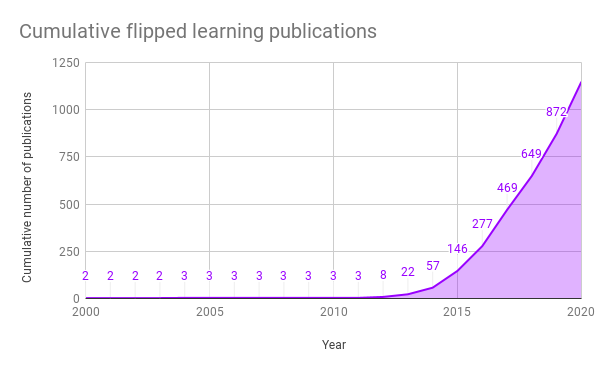
This is classic exponential growth. I update the data once a year in the summer. I fit this with an exponential regression model and the r-squared on this is 0.9425 which indicates an almost perfect fit, and the model suggests that research publications on flipped learning are growing at a rate of 31% per year. Whether research on flipped learning "infects" others --- gets them to use flipped learning themselves --- is an open question but I suspect there's something to that.
Right around the time when the "elbow" of this exponential curve started happening, I started writing my book on flipped learning. I had been blogging about flipped learning ever since 2010. My book came out in 2016 and immediately I started getting requests to come and do talks and workshops about this. I still think of this as the "early days" of flipped learning, like we might think of Covid before the Delta surge. And I noticed four very important things about flipped learning then:
- Almost nobody was using flipped learning. Many faculty hadn't ever heard of it. There was absolutely no "market" for it.
- And yet, there was a huge hunger for what flipped learning had to offer: more active learning, less time lecturing, more personal engagement with students. It spoke to a need and a desire that faculty didn't really even know they had. Flipped learning struck a nerve early and tapped into a groundswell of interest.
- I also noticed how quickly flipped learning took off with faculty once they heard about it. It was truly a viral idea. Workshops were our superspreader events. Faculty would show up, "catch" flipped learning, then go around and "infect" their colleagues. Again, if this is Covid we're talking about, then that's all bad. But with a positive idea, it's good.
- And that's the fourth thing: Flipped learning when first introduced was enormously disruptive, in a good way. Read some of those early papers circa 2015-2017. It improved student engagement and performance. More learning happened. Faculty were happier. Students were (often) happier. It upended the way college instruction worked, in a way that was badly needed.
In other words, the flipped learning pandemic was on --- not incredibly common but spreading, and causing major disruption that higher education badly needed.
Where are we now
Let's fastforward to 2020.
In March 2020, I was in São Paolo, Brazil, working with the engineering faculty at the University of São Paolo on restructuring their curriculum to center it on flipped learning and active learning. I arrived back home on Saturday, March 7. On Tuesday, March 10 we received word that GVSU was closing down for the duration of the semester and all classes were going online, starting the following week. On Monday, March 16, we flipped the switch on what I've come to call the Big Pivot. I was the chair of the Math Department at the time and responsible for shepherding over 1000 students in our math courses --- and the faculty who teach them --- into online versions of those courses, which were never designed to be taught online.
I noticed a couple of things here as well.
First, I noticed that while all faculty were stressed out by the disruption of the Big Pivot, the faculty who were teaching their courses with flipped learning had a much easier time with it than those who did not use flipped learning. In fact many of the latter group, who I consider gifted and accomplished instructors, struggled greatly with the Pivot and were in fact literally close to breaking down.
The second thing I noticed was a sudden influx of requests to give talks and workshops, as well as one-time questions about flipped learning. Up to that point, aside from the gig in Brazil, I had not gotten a single request for this in over a year. I got six requests in March and April alone. This really confused me. I would expect to see a big bump in interest about online teaching or teaching with technology, but flipped learning? Who cares about that?
So I really wondered why this big surge was happening. I posed this question to people whose opinions I value, and I identified three key reasons.
First, the shift to online instruction revealed "continuous exposition", which is a polite way of referring to only using lecture in your classes, to be the ineffective method that it is. Straight lecture was never truly viable since about 1980 when computers became common. But now, when classes are done on Zoom, it's obviously non-viable.
Students knew. I clearly remember my 16-year old, waking up to do her first-period math class on Zoom. In Michigan, in March. It's pitch black outside at 7:30am, it's freezing with a foot of snow on the ground, and you dial into... a lecture about algebra? She came to me one day and said, Dad, why don't they just record the lecture and put it on YouTube? Students never really liked straight lecture, despite what they say; in March 2020 they woke up to this, and we began to discover that if all you have to offer in your class is a talking head, they will go find somewhere else to learn.
Second, we realized in the Big Pivot that we can no longer assume that we have the ability to co-locate. Over hundreds of years, we'd coupled teaching with physical space, but as of March 2020 that was no longer a reliable option. Whatever instruction we use, it has to be something that is decoupled from physical classrooms. We even see that today, as the best laid plans to have this symposium in Edwardsville, IL were scuttled not just by Covid but by weather. And if it's not a pandemic or a snowstorm, it's going to be something else. No longer can we make plans for instruction to take place in a fixed time and space.
Instead, and third, what has to take the place of a passive lecture done in a room that you have to get up and go to, is more active learning that involves students in their own construction of understanding that can and does take place in any environment and any modality.
Flipped learning fits all these needs. When the pandemic hit, faculty and administrators remembered flipped learning, pulled it off the shelf where it had been sitting, and realized it's the perfect fit for the challenges they were facing. And that I think explains the "spring surge" and perhaps explains this symposium too.
Flipped learning wasn't extinct --- it had just gone underground, gone endemic.
The opportunity and the danger
Today, there's both an opportunity in knowing this, and a danger.
The opportunity is that flipped learning, being endemic, is not the wild idea it used to be. The basic premise is familiar to everyone and it makes a ton of sense in the context of an ongoing pandemic. In fact I'd say after 2+ years, almost everyone uses flipped learning in some form, although they may not call it by that name.
But as in all endemics, I also feel as I look around at different implementations of flipped learning, that while more and more people are using it, it's in danger of losing some of its positive disruptive potency. Like chicken pox, or any of the other ideas that were once rare and disruptive but are now common and not that impactful, it's everywhere and nowhere at the same time.
There are three ways that a loss of potency can happen, in my experience.
First, we can lose the focus that flipped learning places on active learning everywhere. It can become nothing more than a choice about where lectures go. When your class becomes all about lectures and the only question is whether students should sit through them before the class time or during, you've lost the plot.
Second, administrators can get involved. I work with our amazing president at GVSU and her cabinet and I mean no disrespect. But when some big idea gets inside the head of a dean or a provost, you know what happens next. They push a change that ought to be coming from faculty -- in fact ought to be coming from students -- and it becomes the flavor of the month like so many failed ideas in higher education before it.
And third, faculty can lose their nerve. Let's face it -- you can't do flipped learning well if you don't on some level enjoy taking risks. Everywhere I go to talk or give a workshop, people give me "What if" questions -- what if students don't do the pre-class work, what if I get bad course evaluations and get fired. And so on. I do give practical suggestions when asked these questions but these days I also say -- You know what? It might all happen. Your entire class might show up one day without doing the preclass work. They might go en masse to the dean's office every day after class to complain that you're not teaching the material. All this and worse may happen. This is not a safe pedagogical choice. The only way to make it safe, is to tone it down, to lower your expectations. You go ahead and reteach the material when students don't do the preclass work. You drop back into lecturing during class time when there are complaints. It makes flipped learning much more palatable. It spreads faster because there's less to dislike. But it loses its potency as it spreads.
Three ways to keep flipped learning potent
So to end here, I want to urge you not to let this happen! And I want to give you three ways to keep it from happening in your own instruction.
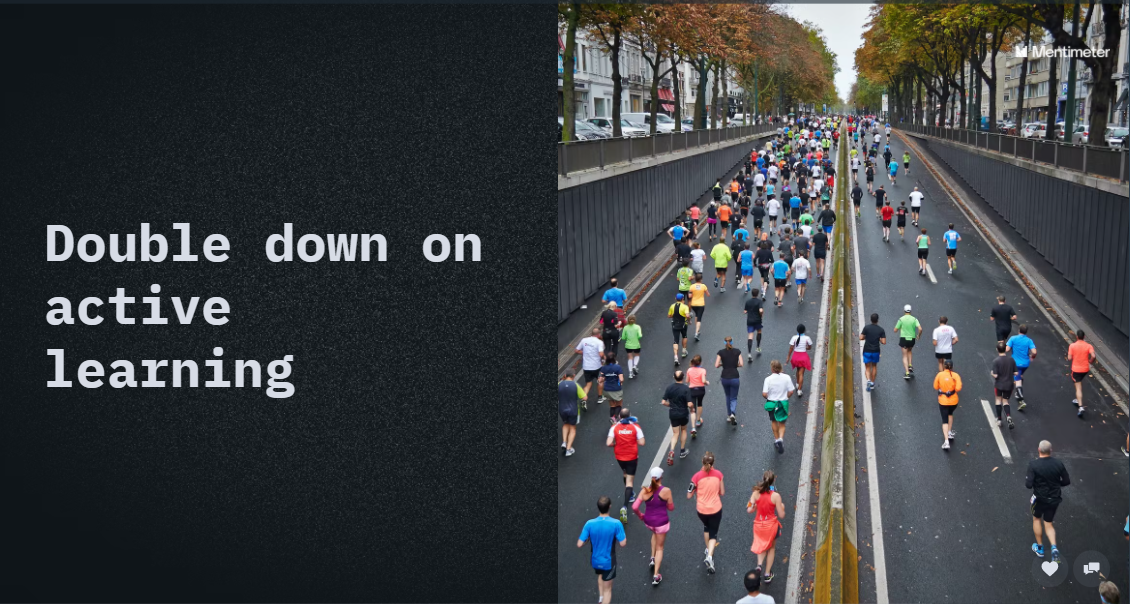
First: Double down on active learning. The entire point of flipped learning is to inject as much active learning as possible in as many different places as possible. It's not about where you put your lectures. It's about putting lectures and all other non-active pedagogies in their place. We know that active learning is best for students on all the metrics that matter. So we adopt flipped learning because we want to optimize and maximize the active learning that takes place.
You do not need to ask for either forgiveness or permission to replace lecture with active learning. But if anybody asks you for a justification, just pull out your own institution's mission statement or strategic plan. I can guarantee you that somewhere in there is a claim that the institution is "Student centered". Point to that statement and ask: Are we really serious about being student centered? And If so, where is it in our pedagogy? Can we really claim to be serious about being student centered when 80% of our classes are taught in straight lecture format? If we're not serious about it, let's be honest instead and say something like "We're student centered, until it becomes risky."
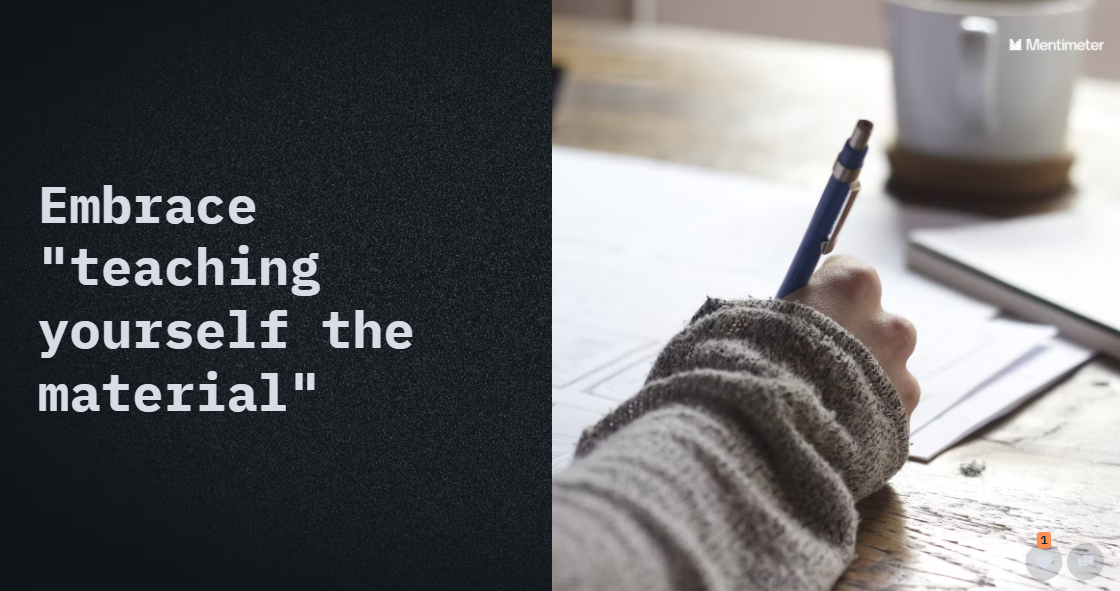
Second: Embrace the concept of having students teach themselves the material. I know what you're thinking. This is probably the most common chestnut on those negative course evaluations you get with flipped learning. "We have to teach ourselves the material in this class!" People say this as if it were a bad thing. But isn't this the whole point of college, to have the skill and the taste for teaching yourself things? This is not a bug of flipped learning, it's a feature. Lean into it. Tell your students you are learning into it, and tell them why, and tell them why a flipped environment is a safe space to build muscle on self-teaching. And then give them your utmost support.
If you still get pushback on this, go back to the mission statement or strategic plan. I can also guarantee you there is something in there about how much your college values lifelong learning. Point to that, and ask Are we really serious about lifelong learning? If so, where and how exactly are we teaching students to become lifelong learners? Or should it instead say "We value lifelong learning, and good luck on figuring out how to do it"?
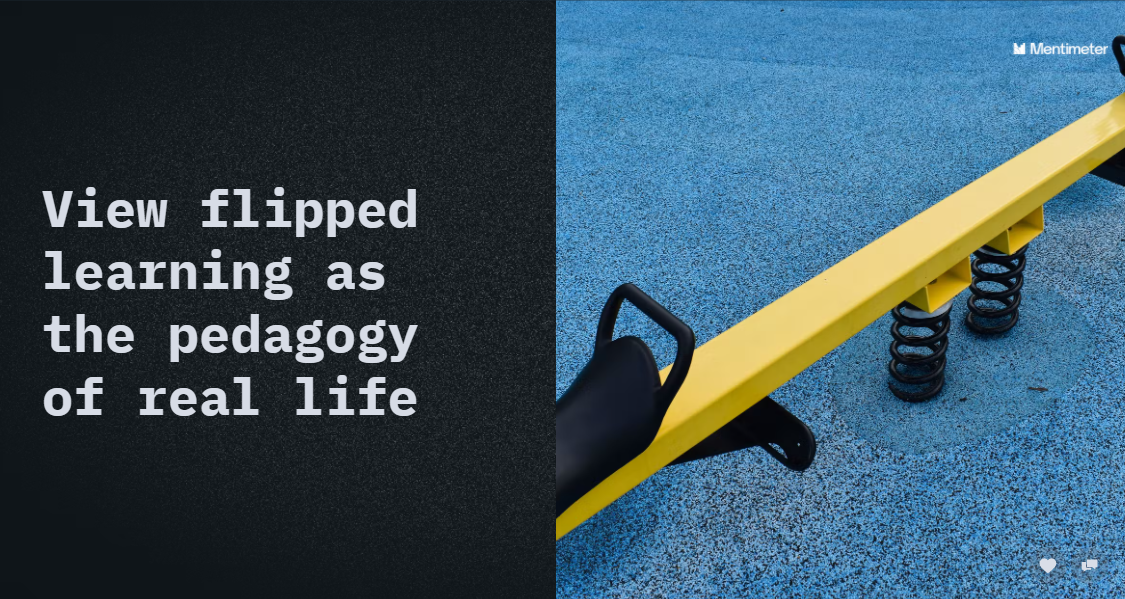
Third: Remember the Big Pivot is not going away. Higher ed through the pandemic has been given a strong dose of real life, and because higher ed has spent much of the last thousand years hermetically sealed away from real life, it's struggled to figure it out. It needs a pedagogical model that fits real life better than the old ones do, and I really think flipped learning is that model. We center on active learning, in all times and places, and in such a way that if you're in person -- great, and if not -- also great. Flipped learning is in many ways pivot-proof. That's what my math faculty colleagues found out when I was department chair and we pivoted --- flipped learning fits the demands of the times really well.
So viewing flipped learning in this way helps you, and it also speaks the language of those administrators, because here's an opportunity to deal effectively with the challenges of not just a Big Pivot but all the small back-and-forth pivots we may need to make in the months to come.
So again, my call to action here is to not let flipped learning become endemic in a bad way --- where it's common but impotent. Keep spreading it through these suggestions I've given here and with the energy you bring out of this symposium! But don't lose your nerve and your disruptive spirit! Keep it potent. And unlike Covid, which we all wish would just go away now, it'll become not "the flipped classroom" but just "the classroom" --- the normative model for all pedagogy in higher ed and a continued positive potent force.
